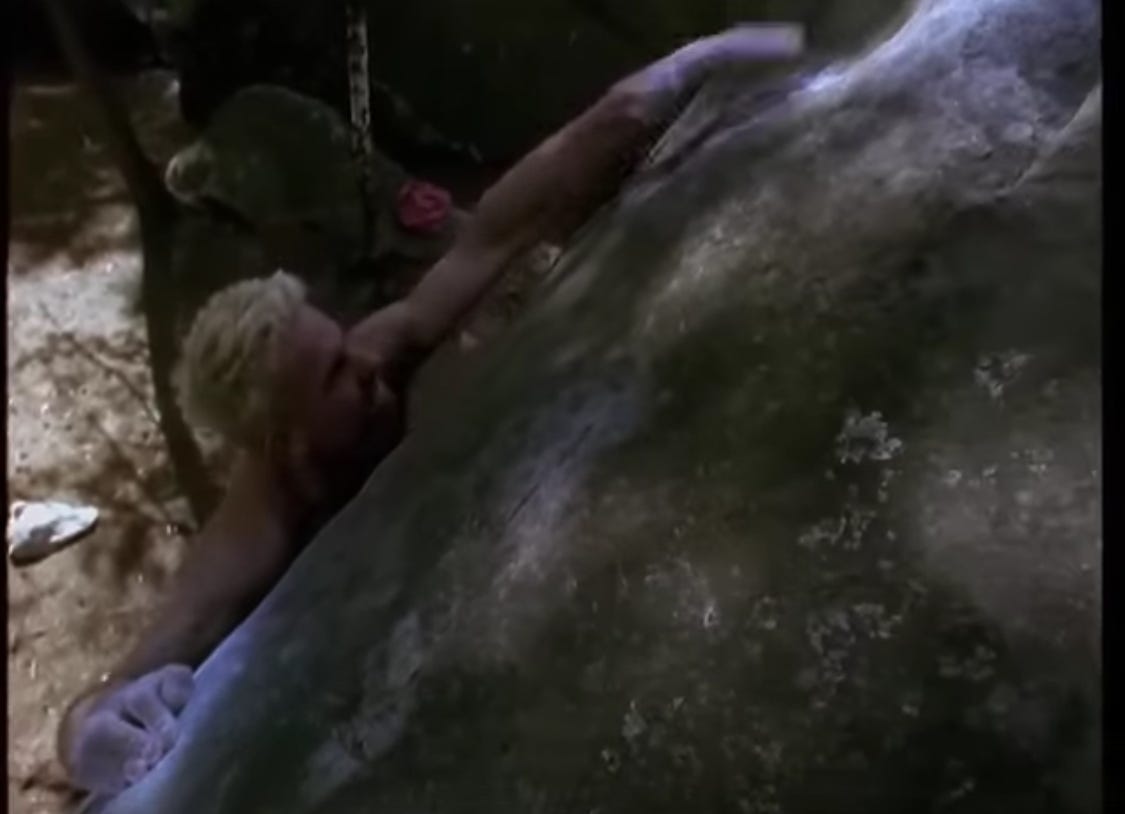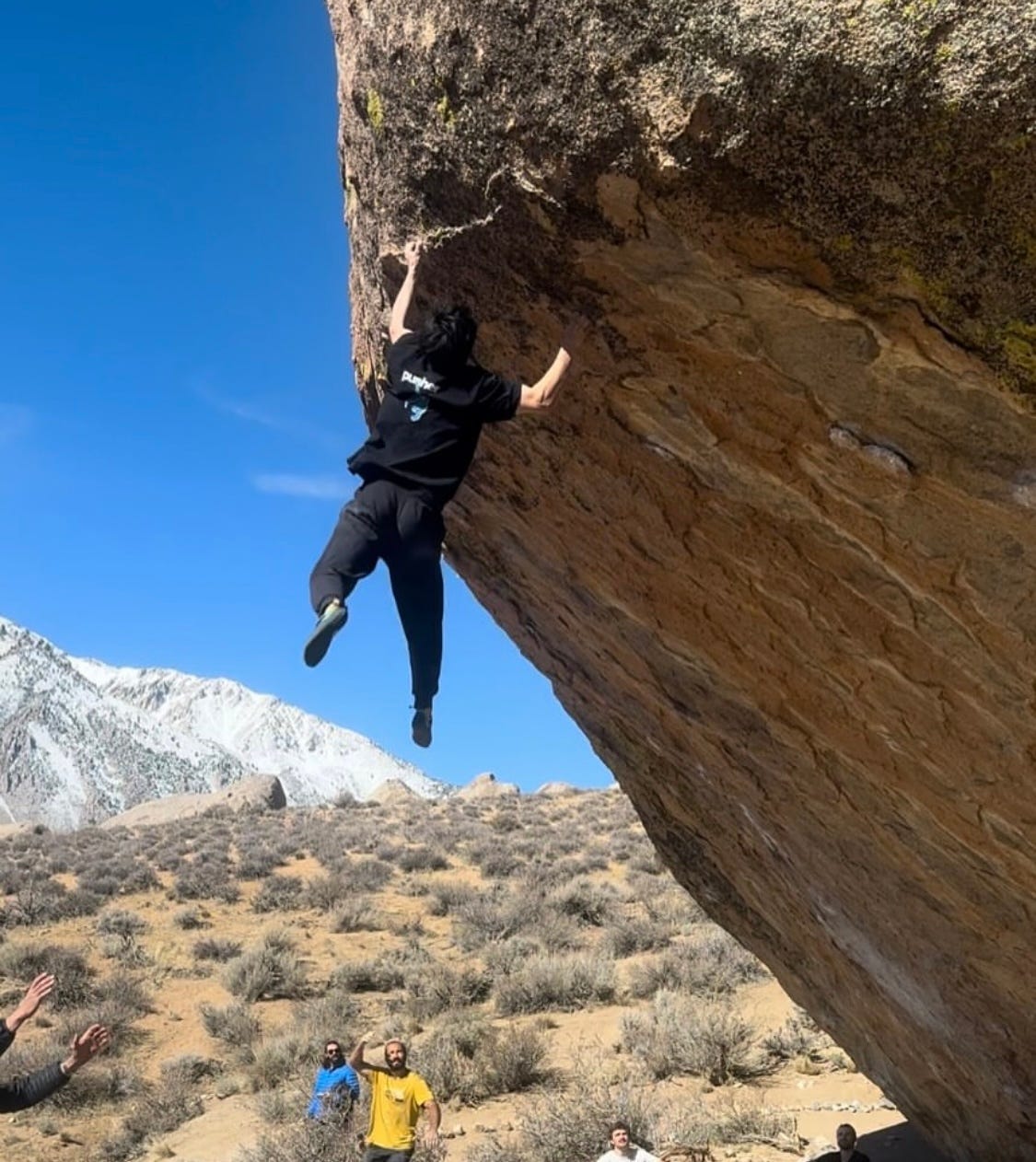*Cover photo via Tension Climbing
They’re in every gym, there’s multiple types, and people have video diaries of their ascents on the internet.
What’s the recent re-obsession with boards? A tool once deemed inaccessible and for a sect of elite climbers has found its way to being an aspirational style of climbing. The access to setting your own problems, getting people from around the world to climb on them, and coming to a grade consensus (soft) has never been easier. All you have to do is pick your favorite board and download an app.
Albeit simplified in many aspects, the modernization of this process is helping to preserve the base of climbing culture and training.
The School Room
Simon Tucker’s The Real Thing chronicles Ben Moon and Jerry Moffatt taking down some of the hardest lines in the UK’s Peak District and in Fontainebleau France in the mid 90s. Toted as the first feature-length bouldering movie ever made, it gives a glimpse into the lives of two of the most prolific climbers at the time. From Ben’s blue tights and Jerry’s speed shades, it embodies what climbing was like at that time, getting after it. There was no social media, no training programs, no downturned shoes. You heard stories about difficult boulders, and you went out and tried to climb them.
The movie has 217,000 views, which is no small feat for a climbing film. While I encourage you to watch the whole movie, YouTube marks the most viewed section starting at 26:00. This is the only part where the climbing does not take place outdoors. Instead it follows a training session of Ben and Jerry at the legendary School Room in Sheffield, England. A techno track blares in the background as the two climbers run through what would be considered a freakish training session even by today’s standards: climbing multiple v11+ boulders on a board with holds that are generally disgusting (a writeup on the Moon Climbing website is a bit kinder to the holds). Disfigured crimps, wood pinches, and bizarre drilled-out pockets adorn the board. At the time, this was the equivalent of receiving secret training intel.
“Getting strong” was harder at the advent of modern climbing because information was scarce. How were Ben and Jerry able to do all of these hard boulders outside? They were putting in hours on the board.
The Schoolroom Board, although in a different location, still exists today and there are professional athletes still coming to climb on it. A two minute video of a young Alex Megos on the board from 2015 has nearly as many views as The Real Thing. Alex even starts his session with the first board boulder shown in the movie, Stuey Five Bellies. Adam Ondra, Magnus Mitdbo, Aiden Roberts, Jim Pope, Molly Thompson-Smith, and David Fitzgerald are just a short list of new school talent that have sought out a session on this iconic wall.
Ben Moon went on to develop the MoonBoard, which through all of its iterations remains the most common option for training boards. Its small size and desirable angle allow it to fit into a small space in a climbing gym, or the garage of your house. Ben was able to transfer his expertise in training and what he learned from the School Room into a tool that is shared throughout the world to determine a consensus for what’s exemplary of each climbing grade.

Hard Climbing
Who doesn’t like climbing hard? You can pinpoint each day you felt light, and all of your projects felt easy. But how do you get there?
Commercial setting is varied but how strong can it make me? Hangboarding and finger lifting protocols are being preached by hundreds of Instagram climbing “coaches”, but is it worth sifting through all this information? Maybe the campus board will translate to climbing best because it’s functional?
Training is harder than ever because it’s complicated. Advancements in methods are great, but it makes it harder for climbers to discern what they should actually be doing to climb harder. Not to mention that one training method can vary wildly in results from person to person due to genetic predispositions and body composition.
Simplicity is the answer.
In a recent interview on the Testpiece Climbing Podcast, former-East-Coast-crusher-now-SLC-transplant Adam Shahar has a controversial take on modern training. Adam explains that he has found the best results climbing on boards and describes the effective training as “pulling, pulling, pulling”. This goes against many of the modern training methods that include a plethora of supplemental exercises and training tools. While Adam does mention these, he says he rations only 25% of his training to supplemental and 75% to board climbing. For reference, Adam has climbed a V16, 5 V15s and qualified for a bouldering world cup semifinal in the last 18 months.

Adam is not the only example of this. Tension’s Board Lords series brings together some of the strongest climbers to throw down on the Tension Board 2. Adam Shahar, the Wheeler Brothers, Zach Galla, Nathaniel Coleman, Allison Vest, Maya Madere, Kerry Scott, Sean Houchins-McCallum, and Hamish McArther are not even a fully inclusive list of climbers that have appeared in the videos. If you watch one episode, it is apparent how freakish these climbers are based off of the unfathomable moves they are doing. One handed crimp catches, iron cross lockoffs, and keeping tension on pebble sized feet—they’re getting this strong climbing on boards. Many of the guests are some of the top contributors/high on the leaderboards for the Tension Board 2, or are in a similar position for their board of choice.
While each major board option (Moon, Kilter, Tension) come with slightly different nuances, the objective is the same. Pull. This seems basic, but as Adam mentions in his Testpiece interview, you learn a lot about movement from climbing on these boards. There is a level of discomfort that comes with board climbing. Everything isn’t where you want it to be. This forces you into positions you might not be comfortable in and you have to figure it out. Micro adjustments are key. How are you placing your hips? Are you toeing in hard enough? When do you combine pushing with your feet and pulling with your hands to generate momentum? How do you control your lower body when cutting feet? How can you position your body under a hold to generate the most pull? You have to work with what you’re given to solve the problem. Nothing less, nothing more.

The Last Bastion of Climbing Culture
Climbing is no longer counterculture. There are over 600 gyms across the US alone, private equity has backed some brands, and we’ve gotten a lacklustre reality TV show. Walking into a gym at peak hours is no longer a small community, but an overpacked, waiting-to-get-on-the-wall simulator. Growth is good, but preservation of culture becomes difficult.
How do we channel Ben and Jerry?
Climbing gyms were born out of necessity. Traveling for outdoor climbing was (and still is) common. Depending on where you are, it might take hours or days to get to a well-known climbing area. When you went back home, the boulders weren’t coming with you. Home walls and small gyms started popping up to scratch the climbing itch. This started the climbing cycle. Train in the gym to smash projects outside, go outside to (hopefully) smash projects, repeat. People wanted to climb hard boulders outside. How do you test your mettle against other climbers? Trying the same boulders as them. Competition climbing was in its infancy, and there was no other way to see how you stack up against the competition.
Boards preserve this inaugural tenet of climbing culture. Anyone can set a boulder on the board, anyone can climb on it, and anyone can vote on what it’s rated. The best boulders are repeated the most, and benchmarks are based on a consensus vote. Grades are democratic. If you can finish the climb, you can suggest a grade. You mark your progress, and can compare with your friends, or people across the world. It’s standardized, everyone is playing by the same rules. People have dedicated board accounts to log their ascents, and some have even gained notoriety from their superhuman board strength. A few boarders to look at are Ben Kim, Ravioli Biceps, and Sean Houchins-McCallum.
Many modern training methods are often chasing numbers. Lifting more weight, doing more reps, hanging for more time. How does this translate to climbing? Training cycles can be frustrating because you can get back on the wall and feel lost, your movement feels stiff, and somehow your grip is never sticky enough. Climbing on boards boils it down. You either do it or you don’t. It revolves more around finding nuance in your climbing style, not chasing a PR that only exists off the wall.
The best part is, it’s better shared with friends. If you’ve had a proper board session, it often feels like the early days you spent in your first climbing gym. You come in, and you get beat up. Spit off things that might be too hard, or maybe you’re just not doing it right. Consult your friends for an ego boost, theorize beta, have a few laughs, and pull harder on your next attempt. There’s few things better than getting a top, feeling a little bit stronger, and getting knucks from the crew. It’s humbling, simple, and fun.







follow me @ihatemoonboarding69
article gets it wrong. Even those who don't send climbs feel compelled and entitled to grade them